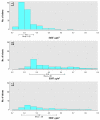A comparison of proximity and land use regression traffic exposure models and wheezing in infants
- PMID: 17384778
- PMCID: PMC1817699
- DOI: 10.1289/ehp.9480
A comparison of proximity and land use regression traffic exposure models and wheezing in infants
Abstract
Background: We previously reported an association between infant wheezing and residence < 100 m from stop-and-go bus and truck traffic. The use of a proximity model, however, may lead to exposure misclassification.
Objective: Results obtained from a land use regression (LUR) model of exposure to truck and bus traffic are compared with those obtained with a proximity model. The estimates derived from the LUR model were then related to infant wheezing.
Methods: We derived a marker of diesel combustion--elemental carbon attributable to traffic sources (ECAT)--from ambient monitoring results of particulate matter with aerodynamic diameter < 2.5 microm. We developed a multiple regression model with ECAT as the outcome variable. Variables included in the model were locations of major roads, bus routes, truck traffic count, and elevation. Model parameter estimates were applied to estimate individual ECAT levels at infants' homes.
Results: The levels of estimated ECAT at the monitoring stations ranged from 0.20 to 1.02 microg/m(3). A LUR model of exposure with a coefficient of determination (R(2)) of 0.75 was applied to infants' homes. The mean (+/- SD) ambient exposure of ECAT for infants previously categorized as unexposed, exposed to stop-and-go traffic, or exposed to moving traffic was 0.32 +/- 0.06, 0.42 +/- 0.14, and 0.49 +/- 0.14 microg/m(3), respectively. Levels of ECAT from 0.30 to 0.90 mug/m(3) were significantly associated with infant wheezing.
Conclusions: The LUR model resulted in a range of ECAT individually derived for all infants' homes that may reduce the exposure misclassification that can arise from a proximity model.
Figures
Similar articles
-
Evaluating heterogeneity in indoor and outdoor air pollution using land-use regression and constrained factor analysis.Res Rep Health Eff Inst. 2010 Dec;(152):5-80; discussion 81-91. Res Rep Health Eff Inst. 2010. PMID: 21409949
-
Traffic-related pollutants and wheezing in children.J Asthma. 2012 Feb;49(1):5-7. doi: 10.3109/02770903.2011.641049. Epub 2012 Jan 3. J Asthma. 2012. PMID: 22211400
-
Exposure to air pollution and respiratory symptoms during the first 7 years of life in an Italian birth cohort.Occup Environ Med. 2014 Jun;71(6):430-6. doi: 10.1136/oemed-2013-101867. Epub 2014 Mar 21. Occup Environ Med. 2014. PMID: 24659182 Free PMC article.
-
The first 1000 days of life: traffic-related air pollution and development of wheezing and asthma in childhood. A systematic review of birth cohort studies.Environ Health. 2021 Apr 17;20(1):46. doi: 10.1186/s12940-021-00728-9. Environ Health. 2021. PMID: 33865406 Free PMC article.
-
A review of land-use regression models for characterizing intraurban air pollution exposure.Inhal Toxicol. 2007;19 Suppl 1(Suppl 1):127-33. doi: 10.1080/08958370701495998. Inhal Toxicol. 2007. PMID: 17886060 Free PMC article. Review.
Cited by
-
Residential greenness, asthma, and lung function among children at high risk of allergic sensitization: a prospective cohort study.Environ Health. 2022 May 12;21(1):52. doi: 10.1186/s12940-022-00864-w. Environ Health. 2022. PMID: 35549707 Free PMC article.
-
Fast inverse distance weighting-based spatiotemporal interpolation: a web-based application of interpolating daily fine particulate matter PM2:5 in the contiguous U.S. using parallel programming and k-d tree.Int J Environ Res Public Health. 2014 Sep 3;11(9):9101-41. doi: 10.3390/ijerph110909101. Int J Environ Res Public Health. 2014. PMID: 25192146 Free PMC article.
-
Residential surrounding greenness and self-reported symptoms of anxiety and depression in adolescents.Environ Res. 2021 Mar;194:110628. doi: 10.1016/j.envres.2020.110628. Epub 2020 Dec 17. Environ Res. 2021. PMID: 33345894 Free PMC article.
-
Residential mobility impacts exposure assessment and community socioeconomic characteristics in longitudinal epidemiology studies.J Expo Sci Environ Epidemiol. 2016 Jun;26(4):428-34. doi: 10.1038/jes.2016.10. Epub 2016 Mar 9. J Expo Sci Environ Epidemiol. 2016. PMID: 26956935 Free PMC article.
-
Ten-eleven translocation 1 (TET1) methylation is associated with childhood asthma and traffic-related air pollution.J Allergy Clin Immunol. 2016 Mar;137(3):797-805.e5. doi: 10.1016/j.jaci.2015.10.021. Epub 2015 Dec 10. J Allergy Clin Immunol. 2016. PMID: 26684294 Free PMC article.
References
-
- Akaike H. 1973. Information theory and an extension of the maximum likelihood principle. In: Second International Symposium on Information Theory (Petrov BN, Csaki F, eds). Budapest:Akademiai Kiado, 267–281.
-
- Birch ME, Cary RA. Elemental carbon based method for monitoring occupational exposures to particulate diesel exhaust. Aerosol Sci Tech. 1996;25:221–241. - PubMed
-
- Brauer M, Hoek G, van Vliet P, Meliefste K, Fischer P, Gehring U, et al. Estimating long-term average particulate air pollution concentrations: application of traffic indicators and geographic information systems. Epidemiology. 2003;14:228–239. - PubMed
-
- Briggs DJ, Collins S, Elliott P, Fischer P, Kingham S, Lebret E, et al. Mapping urban air pollution using GIS: a regression-based approach. Int J Geogr Inf Sci. 1997;11:699–718.
Publication types
MeSH terms
Substances
Grants and funding
LinkOut - more resources
Full Text Sources



